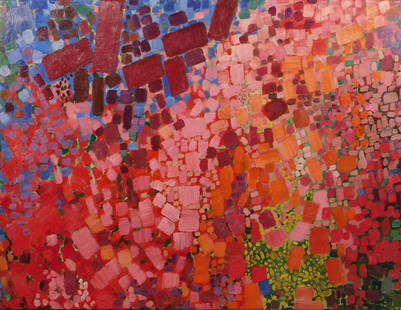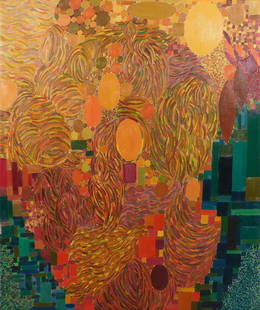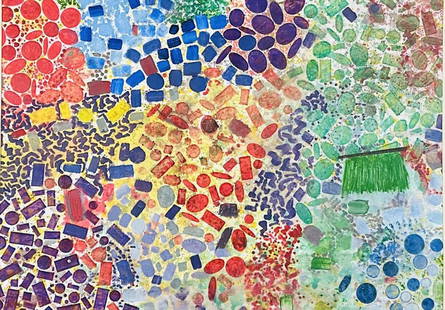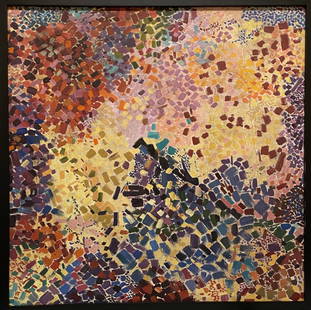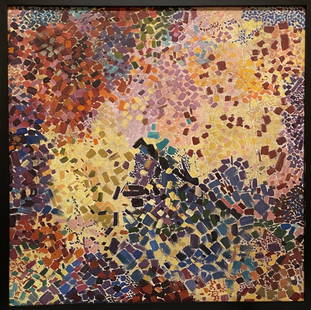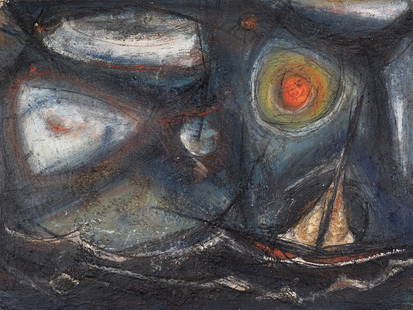
LYNNE DREXLER (1928-1999) Grass Symphony, 1962
Lynne Drexler Sale History
View Price Results for Lynne DrexlerRelated Paintings
More Items from Lynne Drexler
View MoreRecommended Art
View More





Item Details
Description
LYNNE DREXLER (1928-1999)
Grass Symphony, 1962
signed, titled and dated 'LYNNE DREXLER Grass Symphony 1962' (on the reverse)
oil on canvas
48 1/4 x 62 1/4 in.
122.6 x 158.1 cm.
Footnotes:
Provenance
Vallarino Fine Art, New York (acquired directly from the estate of the artist)
McCormick Gallery, Chicago (acquired directly from the above)
Acquired directly from the above by the present owner in 2016
Exhibited
Chicago, McCormick Gallery, Early Spring: An Exhibition of Works by Lynne Drexler, 17 April-5 June 2010
Lynne Drexler's Grass Symphony is an indisputable masterpiece produced during her most sought-after period, in 1962. This painting was created after marrying her long-term partner, John Hultberg, and spending their first summer at Monhegan Island in Maine, a haven that would be a font of inspiration throughout Drexler's lifetime and where she would permanently reside from 1983. Grass Symphony demonstrates the comprehensive advancement of Drexler's style that was largely overlooked by the critics of her day who failed to appreciate the scope of her talent and sensitivity to the formal and imagistic questions of painting after Abstract Expressionism. Her ambition and technique here is synthesized with an eloquence and completeness that defy her relative youth and surpass many of her New York avant-garde associates; qualities that have at last been recognized as truly defiant and extraordinary. A shimmering rhapsody of blues and greens, punctuated by verses of red and yellow, in Grass Symphony there is a beauty and freshness that is exhilarating to behold over an elegant scale. It stands as a timeless and desirable painting by Drexler, conjuring the Water Lilies of Claude Monet, the patchwork of Gustav Klimt, and the bright colors of her famed teacher Hans Hofmann.
Often labeled a second-wave abstract expressionist, Drexler's paintings go further than the medium-specific theories that underpinned New York's chief movement of the 1950s and encapsulate a lyrical abstraction that owes much to Pointillism and Impressionism. She was born in Virginia in 1928, the daughter of a distinguished Southern family. Attending the College of William & Mary in Williamsburg, she studied under modernist architect and designer Ward Bennett and Peter Kahn – brother of Wolf Kahn – who implored her to study in New York under Hans Hofmann; her innate gift was self-evident from her earliest years. Her move to New York in 1956 marked her artistic departure in earnest. Studying under Hofmann, Drexler's painting developed a chromatic potency that was informed by Hofmann's color and spatial theories, often referred to as his notion of 'push-pull' painting. His influence was fundamental to her employment of color as a formal device – suppressing areas, elevating discrete passages, and building composition through a variety of tonal modulations. In 1958, after Hofmann stepped away from teaching, Drexler enrolled at Hunter College where she would subsequently come under the close pupillage of Robert Motherwell. He instilled in her a confidence and commitment to her process that, by the end of the 1950s, had become expansive, refined, and uniquely her own.
Like pre-war Paris before it, New York offered a melting pot of ideas and ambition across the arts, centering around Greenwich Village, where Drexler was a regular feature at the 8th Street Club and the famed Cedar Tavern, host to the avant-garde that included Jackson Pollock, Franz Kline, Philip Guston, Grace Hartigan, and Willem de Kooning. Her first solo exhibition came in 1961 at Tanager Gallery, the same year she met her soon-to-be husband, John Hultberg. Married on May 25, 1962, Hultberg's gallerist at the time, Martha Jackson, offered the couple a house on Monhegan Island to escape New York for several months. The summer of 1962, spent at Monhegan, was massively significant for both Drexler's life and art. It became a creative repository and source, nourishing her sense of color and composition. In Grass Symphony, there is an undeniable sense of land abutted by sea – of bluffs and a ragged promontory. The title doubles down on this ethereal sense of place; the delicate wash of grassland bowing in a sea breeze and water breaking from a few dunes back.
In this way, Drexler evokes the Water Lilies of Monet above all else. As an artist who could equally be termed a post-impressionist, her paintings – as abstract and process-based as they are – teeter on the cusp of landscape and vista, of flora and thicket. In this vein, to quote Leo Steinberg's words on Monet's Water Lilies acquired by New York's Museum of Modern Art in 1955 – a painting that Drexler would likely have seen before it was tragically lost in the infamous fire at the museum in April of 1958 – his impression could easily be applied to Drexler in this instance: 'the laws of gravity – that splendid projection of the human mind lodged in its body – is abrogated [...] The whole world is cut loose from anthropomorphic or conceptual points of reference. Those points are still available, but they no longer constitute the world' (Leo Steinberg, 'Monet's Water Lilies', Other Criteria: Confrontations with Twentieth-Century Art, Chicago, 1974, p. 239).
Whilst Grass Symphony has the faculty to manifest a sense of place, it remains an abstract triumph, a testament to the accomplishment of Drexler's singular paint handling and style. Musicality was the emotional center of her practice, applying rhythm and resonance to color and composition alike – a premise likely gleaned from Hofmann who championed a scalar approach to painting. In famed anecdotes, during her time in New York between 1959-1962 she would regularly attend concerts at Carnegie Hall and the Metropolitan Opera, furnished with a sketchbook and colored pencils, to translate the music into dynamic conceptual visual scores. In the present work, this intense awareness of tempo and structure, expressed in spatial and formal vocabularies, is palpable. Drexler's brushwork appears quick but precise, striking each note of the painting with verve. Absorbing passages in isolation, one gets a sense of a cosmic scale and underlying order that constitutes the whole.
After their summer in 1962, Drexler and Hultberg would leave New York and not return until the end of the 1960s, rekindling their relationship with Monhegan in 1971 when they would purchase the house Martha Jackson had offered them nearly ten years earlier. As such, Grass Symphony can undoubtedly be considered one of the most important paintings of this early sequence, and wonderfully definitive of Drexler's relationship with the island that would go into hiatus during the 1960s, though Drexler consistently revisited memories and sketches of her time at Monhegan. A patchwork of blues and greens, what culminates is an operatic aria that illustrates the symphonic approach that makes Drexler one of the great painters of her generation, and Grass Symphony a true masterpiece of this pivotal period.
Grass Symphony, 1962
signed, titled and dated 'LYNNE DREXLER Grass Symphony 1962' (on the reverse)
oil on canvas
48 1/4 x 62 1/4 in.
122.6 x 158.1 cm.
Footnotes:
Provenance
Vallarino Fine Art, New York (acquired directly from the estate of the artist)
McCormick Gallery, Chicago (acquired directly from the above)
Acquired directly from the above by the present owner in 2016
Exhibited
Chicago, McCormick Gallery, Early Spring: An Exhibition of Works by Lynne Drexler, 17 April-5 June 2010
Lynne Drexler's Grass Symphony is an indisputable masterpiece produced during her most sought-after period, in 1962. This painting was created after marrying her long-term partner, John Hultberg, and spending their first summer at Monhegan Island in Maine, a haven that would be a font of inspiration throughout Drexler's lifetime and where she would permanently reside from 1983. Grass Symphony demonstrates the comprehensive advancement of Drexler's style that was largely overlooked by the critics of her day who failed to appreciate the scope of her talent and sensitivity to the formal and imagistic questions of painting after Abstract Expressionism. Her ambition and technique here is synthesized with an eloquence and completeness that defy her relative youth and surpass many of her New York avant-garde associates; qualities that have at last been recognized as truly defiant and extraordinary. A shimmering rhapsody of blues and greens, punctuated by verses of red and yellow, in Grass Symphony there is a beauty and freshness that is exhilarating to behold over an elegant scale. It stands as a timeless and desirable painting by Drexler, conjuring the Water Lilies of Claude Monet, the patchwork of Gustav Klimt, and the bright colors of her famed teacher Hans Hofmann.
Often labeled a second-wave abstract expressionist, Drexler's paintings go further than the medium-specific theories that underpinned New York's chief movement of the 1950s and encapsulate a lyrical abstraction that owes much to Pointillism and Impressionism. She was born in Virginia in 1928, the daughter of a distinguished Southern family. Attending the College of William & Mary in Williamsburg, she studied under modernist architect and designer Ward Bennett and Peter Kahn – brother of Wolf Kahn – who implored her to study in New York under Hans Hofmann; her innate gift was self-evident from her earliest years. Her move to New York in 1956 marked her artistic departure in earnest. Studying under Hofmann, Drexler's painting developed a chromatic potency that was informed by Hofmann's color and spatial theories, often referred to as his notion of 'push-pull' painting. His influence was fundamental to her employment of color as a formal device – suppressing areas, elevating discrete passages, and building composition through a variety of tonal modulations. In 1958, after Hofmann stepped away from teaching, Drexler enrolled at Hunter College where she would subsequently come under the close pupillage of Robert Motherwell. He instilled in her a confidence and commitment to her process that, by the end of the 1950s, had become expansive, refined, and uniquely her own.
Like pre-war Paris before it, New York offered a melting pot of ideas and ambition across the arts, centering around Greenwich Village, where Drexler was a regular feature at the 8th Street Club and the famed Cedar Tavern, host to the avant-garde that included Jackson Pollock, Franz Kline, Philip Guston, Grace Hartigan, and Willem de Kooning. Her first solo exhibition came in 1961 at Tanager Gallery, the same year she met her soon-to-be husband, John Hultberg. Married on May 25, 1962, Hultberg's gallerist at the time, Martha Jackson, offered the couple a house on Monhegan Island to escape New York for several months. The summer of 1962, spent at Monhegan, was massively significant for both Drexler's life and art. It became a creative repository and source, nourishing her sense of color and composition. In Grass Symphony, there is an undeniable sense of land abutted by sea – of bluffs and a ragged promontory. The title doubles down on this ethereal sense of place; the delicate wash of grassland bowing in a sea breeze and water breaking from a few dunes back.
In this way, Drexler evokes the Water Lilies of Monet above all else. As an artist who could equally be termed a post-impressionist, her paintings – as abstract and process-based as they are – teeter on the cusp of landscape and vista, of flora and thicket. In this vein, to quote Leo Steinberg's words on Monet's Water Lilies acquired by New York's Museum of Modern Art in 1955 – a painting that Drexler would likely have seen before it was tragically lost in the infamous fire at the museum in April of 1958 – his impression could easily be applied to Drexler in this instance: 'the laws of gravity – that splendid projection of the human mind lodged in its body – is abrogated [...] The whole world is cut loose from anthropomorphic or conceptual points of reference. Those points are still available, but they no longer constitute the world' (Leo Steinberg, 'Monet's Water Lilies', Other Criteria: Confrontations with Twentieth-Century Art, Chicago, 1974, p. 239).
Whilst Grass Symphony has the faculty to manifest a sense of place, it remains an abstract triumph, a testament to the accomplishment of Drexler's singular paint handling and style. Musicality was the emotional center of her practice, applying rhythm and resonance to color and composition alike – a premise likely gleaned from Hofmann who championed a scalar approach to painting. In famed anecdotes, during her time in New York between 1959-1962 she would regularly attend concerts at Carnegie Hall and the Metropolitan Opera, furnished with a sketchbook and colored pencils, to translate the music into dynamic conceptual visual scores. In the present work, this intense awareness of tempo and structure, expressed in spatial and formal vocabularies, is palpable. Drexler's brushwork appears quick but precise, striking each note of the painting with verve. Absorbing passages in isolation, one gets a sense of a cosmic scale and underlying order that constitutes the whole.
After their summer in 1962, Drexler and Hultberg would leave New York and not return until the end of the 1960s, rekindling their relationship with Monhegan in 1971 when they would purchase the house Martha Jackson had offered them nearly ten years earlier. As such, Grass Symphony can undoubtedly be considered one of the most important paintings of this early sequence, and wonderfully definitive of Drexler's relationship with the island that would go into hiatus during the 1960s, though Drexler consistently revisited memories and sketches of her time at Monhegan. A patchwork of blues and greens, what culminates is an operatic aria that illustrates the symphonic approach that makes Drexler one of the great painters of her generation, and Grass Symphony a true masterpiece of this pivotal period.
Buyer's Premium
- 27.5% up to $25,000.00
- 26% up to $1,000,000.00
- 20% above $1,000,000.00
LYNNE DREXLER (1928-1999) Grass Symphony, 1962
Estimate $500,000 - $700,000
26 bidders are watching this item.
Shipping & Pickup Options
Item located in Los Angele, CA , usSee Policy for Shipping
Payment

TOP



















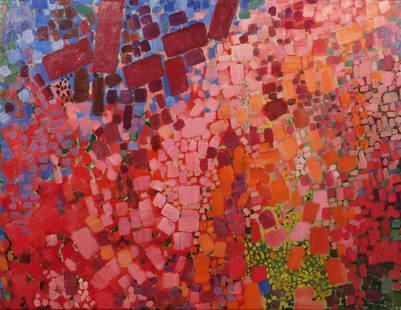
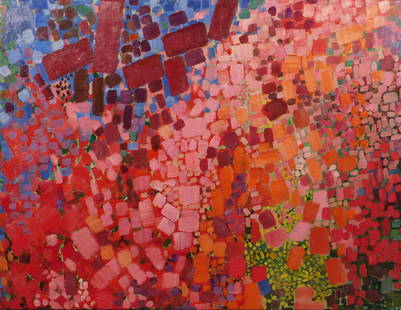
![Lynne Drexler 1968 Oil on Canvas Art: 24" x 18" Fr: 27" x 21" w/COA: Shipping in USA $ 140. Shipping in USA $ 150. Lynne Drexler was born on May 21, 1928 and raised in the Newport News, Virginia area.[1][2] Her parents were Norman E. Drexler, a manager at a public util](https://p1.liveauctioneers.com/1496/281173/148194386_1_x.jpg?height=310&quality=70&version=1678413288)
